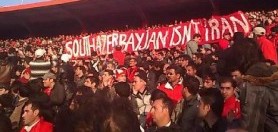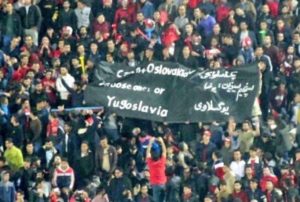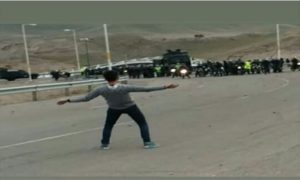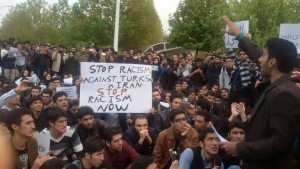
By Dr. Alireza Asgharzade*
![]()
![]() The history of what is now known as Iran is a history of various ethnic groups, languages and cultures coexisting amongst one another from time immemorial. For as long as history can remember, ever since the establishment of the first Elamite civilization around 5000 BC, Iran has been a multiracial, multicultural and multilingual society. According to historians, the first major government was established in the region by the emergence of the Elamite dynasty around 2,250 BC(Field, 1939; Zehtabi, 1999; Asgharzadeh, 2007). An indigenous people to the region, the Elamites were founders of a rich culture and civilization. They had their own unique alphabet and they spoke an agglutinative, non-Indo-European, non-Semitic language. The Elamites ruled in the region for 2,210 years, until their dynasty disintegrated in the year 640 BC (Diakonov, 1965; Sadr, 1997). Alongside the Elamites, other cultures having agglutinative, Afro-Asiatic, and Semitic languages are documented to have co-existed in the region (Biruni, 1879; Field, 1939; Istakhri, 1961).
The history of what is now known as Iran is a history of various ethnic groups, languages and cultures coexisting amongst one another from time immemorial. For as long as history can remember, ever since the establishment of the first Elamite civilization around 5000 BC, Iran has been a multiracial, multicultural and multilingual society. According to historians, the first major government was established in the region by the emergence of the Elamite dynasty around 2,250 BC(Field, 1939; Zehtabi, 1999; Asgharzadeh, 2007). An indigenous people to the region, the Elamites were founders of a rich culture and civilization. They had their own unique alphabet and they spoke an agglutinative, non-Indo-European, non-Semitic language. The Elamites ruled in the region for 2,210 years, until their dynasty disintegrated in the year 640 BC (Diakonov, 1965; Sadr, 1997). Alongside the Elamites, other cultures having agglutinative, Afro-Asiatic, and Semitic languages are documented to have co-existed in the region (Biruni, 1879; Field, 1939; Istakhri, 1961).
![]() About four thousand years after the formation and flourishing of various cultures in the region, a new ethnographic development took place in the Iranian Plateau, and it was the arrival of waves of nomadic groups to the plateau who later came to be known as ‘Aryans’ or ‘Indo-Europeans.’ There is no uniform consensus on the exact points of origination and departure of these nomadic groups. While some have identified their origins in India, others have cited such places as central Asia, Southern Russia, Caucasia, and so on (Ghirshman, 1963; Poliakov, 1974). According to one dominant view,
About four thousand years after the formation and flourishing of various cultures in the region, a new ethnographic development took place in the Iranian Plateau, and it was the arrival of waves of nomadic groups to the plateau who later came to be known as ‘Aryans’ or ‘Indo-Europeans.’ There is no uniform consensus on the exact points of origination and departure of these nomadic groups. While some have identified their origins in India, others have cited such places as central Asia, Southern Russia, Caucasia, and so on (Ghirshman, 1963; Poliakov, 1974). According to one dominant view,
“The majority of the Aryans left their homes in southern Russia for the plains of central Asia; only the near-Iranian Scyths and a few genuine Aryans remained there. The Hyrcanians settled along the northern slope of Alborz and the coastal plain below, south of the sea to which they gave their name. “(Olmstead, 1948, p. 19)
The first wave of these ‘Indo-European’ immigrants arrived in Iran around 2000 BC.Finding the area extremely rich and resourceful, they encouraged other ‘Aryan’ nomadic groups to join them. Around 1200 BC these new immigrants had reached western and central parts of current Iran. The first Indo-European state was created in Iran in 550 BC through the disintegration and subsequent replacement of the Median dynasty by the Achaemenians (see also Dandamaev, 1989; Dandamaev and Lukonin, 1989). After ruling for 220 years, the Achaemenid Dynasty was put an end to through the invasion of Iran by Alexander the Great in 330 BC. After the death of Alexander in 323 BC, three of his officers divided his empire amongst themselves, each of them ruling over a segment of the empire and its population. Ever since then, Iran has continued to be ruled by the Greeks, Arabs, Turks, Persians, and others.
In the year 637 AD, Arab-Islamic forces defeated the Sasanid regime in the famous battle of Qadisiyya and started spreading the Islamic faith throughout the region. The new faith spoke of the equality of all individuals before God and promised the establishment of a society with more equitable living conditions. With their high taxes and never-ending internal strifes and external wars, the Sasanid rulers had all but lost any popular power bases within and among the masses of people. In the course of the Sasanid rule, class divisions had increased incredibly and had become overtly visible even to the unconcerned and politically unconscious masses of the populace. Signs of discontent and dissatisfaction were evident all over the plateau, so much so that when the Isamic-Arab forces attacked the country, the masses of the people showed no interest in defending the decaying Sasanid regime (see also Zerrinkoob, 1957; Lambton, 1969 ; Pirniya, 1983; Morgan, 1988).
The introduction of Islamic civilization to Iran fundamentally transformed the existing political, cultural, linguistic, and of course religious landscapes of the region.Zarathustrianism lost its status as an important religion in the country and was gradually replaced by Islam. This replacement, however, was not total and adherents to the faith of Zarathustra still continued to live in some parts of the country, while a large segment of them migrated to India. On the cultural front, perhaps a most significant development was the establishment of the modern Farsi language with a new Arabic alphabet. Soon after the Islamic conquest, the Arabic language became the major language of science, philosophy, literature, and governance. Such important Iranian scholars as Al-Razi (d. 932), Al-Khawarizmi (780 – 850), Al-Biruni (973 – 1048), and Ibn Sina (Avicenna) (973-1037), produced their major works in Arabic. After about two centuries, the modern Farsi language was gradually developed that not only used the Arabic alphabet, but relied heavily on the Arab language and Arabic traits in its structure and vocabulary.Even the style and form of poetry writing in Iran was fundamentally changed, following the Arabic style of rhythm, rhyming and form.
For nearly two centuries the Umayyad Caliphs ruled the Islamic world from the center of their power in Medina and Damascus. Rulers and governors were assigned to different territories, regulated the running of their provinces and responded to the Caliph directly.Around the mid-eighth century, the Umayyad Caliph was defeated and the Abbasids took the reins of power. They transferred the capital city to Baghdad and ruled from there until 1258, when the Mongol invasion put an end to their rule. The disintegration of the Caliphate in Baghdad culminated in the emergence of local dynasties throughout the region. Tribal dynasties and local kingdoms such as the Samanids, Ziyarids, Deylamites, Ghaznavids and Kharazmis continued to rule over territories and localities.This long period also witnessed various invasions such as that of the Mongols, Tamerlane’s, and others.
In the year 1501, Shah Ismail Safavi of Ardabil was able to bring together the local dynasties of Qaraqoyunlu and Aqqoyunlu and found the Safavid dynasty. The Safavid succeeded in establishing Shiism as the national religion of Iran and uniting the country from the Caspian Sea to the Persian Gulf, and from Mesopotamia to India and Central Asia. Under the Safavids, various tribes and ethnic groups remained relatively autonomous in practicing their traditions, cultures and languages within the loosely governed empire (Mazzaoui, 1972; Woods, 1976; Savory, 1980).
While Orientalists and the dominant Fars-centered literature attempted to present the Safavids as Persians, the fact remained that they were of Turkic origin and Azeri-Turkic was the main language of Shah Ismail’s court, followed by Farsi and Arabic, respectively. Moreover, Shah Ismail was a great lover of poetry and literature. Under the pen name Khatayi, Shah Ismail produced his famous Divani Xetayi in Azeri-Turkic. A unique literary style known as “Qoshma” was also introduced in this period, utilized and developed by Shah Ismail and later on by his successor Shah Tahmasp. In 1722 the Qandhar-based Afghan tribes, adhering to the Sunni branch of Islam, defeated the ill-equipped and increasingly weakened Safavid Army and brought to an end the central rule of the Safavid dynasty that had persisted for over two centuries. Thus, the central authority yet again collapsed and various regional powers and local dynasties emerged as important power bases, negotiating the running of their own territories and kingdoms.A period of civil unrest, ethnic rivalry and racial tension ensued (Lockhart, 1958).
In 1779 the Azerbaijani-Turkic speaking Qajars of Azerbaijan managed to defeat a number of mainly regional rulers and extend their rule all over Iran as early as the beginning of the 19th century (see also Bakhash, 1978). In their official documents, the Qajars frequently referred to the name of the country they ruled as “Mamalek-e Mahruseh-ye Iran” (the Protected Countries of Iran) signifying the federalist and confederative geopolitical structure of the country. Aside from other transformations, two important developments took place in the Qajar era that continued to influence issues of difference, diversity, and ethnic pluralism in Iran up to present day. In the geopolitical sphere, the Qajars lost on two occasions large segments of Azerbaijani-Iranian territory to the Russian Empire. In 1813, the year of the ‘Golestan Peace Treaty’ the Iranian government handed over Qarabagh, Genje, Shirvan, Sheki, Baki, Derbend, Kuba and other territories to the Russian emperor. And again in 1828, by way of Turkman-Chay Treaty, Nexchivan, Ordubad and other territories were handed over to the Russians (Kazemzadeh, 1968).
In terms of religious developments, the Qajar period saw the emergence of a religious movement under the leadership of Sayyid Ali Muhammad (1819-1850), better known as Bab (The Gate). Otherwise known as the Babi movement, this religious movement grew out of Shia Islamic thought and found some followers in the country (Bosworth and Hillenbrand, 1983; Amanat, 1989). The Babis did not play a significant social and political role in Iranian society. However, they inspired another religious movement, Bahaisim, that definitely had far more religious, social, cultural, and political consequences. Initially founded and led by Mirza Hussein Ali (1817-1892) “Baha’u’lllah,” (Glory of God), Bahaisim continued to survive and attract followers in Iran up until the Islamic revolution of 1979. After the establishment of Islamic rule in Iran, Bahaism became an outlawed religion, with its practitioners being persecuted openly. This case added another category of religion-based racism, exclusion, and oppression to the already existing racist order. Meanwhile, the Bahai faith spread quickly beyond Iranian borders, having acquired considerable followers in Europe, India, Asia, and North America. Currently the Bahai faith has developed into a world religion, completely independent from Islam.
The early 20th century marked the beginning of a new national and social consciousness in Iran. Influenced by various literary and socio-political trends in the wake of the Russian Revolution of 1905, many writers, intellectuals and poets began to revolutionize the Iranian socio-cultural landscape. Fathali Akhundzadeh introduced drama into Iranian literature. Taliboff and Zeynal-Abedin of Maragheh were promoting their modern genre of imaginative prose, social criticism and literary realism hitherto unknown in Iran. At the same time, Jalil Memet-Quluzadeh and Aliakbar Saber were attacking the oppressive authority of feudal lords, religious despotism and reactionary ruling elite by way of their merciless social and political satires, widely spread through the paper Molla Nesred-Din. In Tabriz, Mirza Hasan Rushdiyya had laid the foundation of modern schooling and pedagogy. He had written the first ever modern textbooks in the history of Iran, entitled Ana Dili (the mother tongue) and Veten Dili (the language of homeland) to be used in Azerbaijani schools (see also Berengian, 1993, p. 47).Moreover, the ideals of social justice, equality, and humanism vis-à-vis the struggle against colonialism, oppression, religious bigotry and reaction were being promoted through the works of many writers and intellectuals in Farsi, Azeri-Turkic, Kurdish, Arabic, and other languages.
All these cultural, literary, and social activities culminated in the birth of a politico-intellectual movement in 1906 that came to be known as the Constitutional Revolution.The Constitutional Revolution had its popular bases in Azerbaijan, being led by such Azeri leaders as Sattar Khan, Baqer Khan, Heydar Amuoglu, and others. Aside from the Azerbaijanis, other ethnic groups such as the Bakhtiyaris, Armenians, and Persians took active parts in guaranteeing the victory of the movement. At this time, the country was ruled by the Azeri-speaking Qajars, whose language and ethnic policies were not discriminatory and exclusionary, based on language or ethnicity. Under the Qajars, no single language was elevated to the status of official / national tongue of the country; nor was any language or ethnic group vilified and demonized for not being ‘Aryan.’ The Qajar era of Memalek-e Mahruseh-ye Iran ( independent kingdoms of Iran) was a recognized multiethnic, multicultural, and multilingual society governed through a loose form of federalism where all ethnic groups were free to use, study, and develop their languages, literatures, cultures, traditions, and identities.
Ervand Abrahamian (1979) has provided an excellent picture of linguistic diversity during the Constitutional Revolution:
“The geographical barriers were compounded often by linguistic differences. Persians, Bakhtiyaris, Qashqayis, Arabs, and Lurs lived in the Central Plateau. Small groups of Baluchis, Afshars, and Arabs were scattered in the southern deserts. Kurds, Lurs, Arabs, Afshars, and Mamesenis inhabited the western mountains. Azeris, Shahsavans, Kurds, together with scattered settlements of Armanians and Assyrians, lived in the northeastern districts. Gilakis, Taleshis, and Mazandaranis populated the Caspian provinces. Finally, Persians, Turkomans, Kurds, Shahsavans, Afshars, Timurs, Balushis, Tajiks, and Jamshids resided in the northeastern regions. Iran, thus, was a land of linguistic diversity. “(1979, p. 389)
As the movement’s title suggests, constitutionalism was one of the obvious aims of this revolution. The leaders of the movement demanded that the monarch should not enjoy absolute power but should rule based on a constitution adopted by the people’s representatives. This debate was immediately followed by the introduction of new concepts to the political lexicon of the country. Prominent among these concepts were terms such as secularism, nationalism, and the role of religion. The religious segment of intellectuals and elites under the leadership of prominent clerics such as Ayatollah Sheikh Fazlollah Nouri vehemently opposed secularism; nor did they approve of the idea of a secular state detached from Shia religious doctrines and the teachings of sharia.
In contrast to the religious trend, a more confrontational secularist trend emerged that increasingly came to find its expression in both democratic and nationalist views and slogans. This ‘nationalism,’ which was initially envisioned based on the rights of the individual / citizen, failed to define itself in an inclusive fashion. More and more, the term “Irani” (to be an Iranian) came to be equated with Fars / i (to be Persian). This nationalism was thus articulated in terms of an ethnic nationalism based exclusively on Persian language and culture. Such reactionary nationalism sought to glorify Iran’s pre-Islamic past by blaming Islam and the Arabs as responsible for all the ills of the country, where Iran’s backwardness and lack of progress were seen as caused by Islam and the Arabs who were portrayed as destroyers of Iran’s supposedly superior civilization.
As expected, a Fars-centered ethnic nationalism failed to include in a democratic manner the non-Persian groups and nationalities within an emancipatory discourse. In spite of this, the non-Persian ethnic groups and their representatives in the parliament managed to insert in the constitutional text a very important article regarding the formation of “Anjomanha-ye Ayalati va Velayati” (the local and provincial councils).Although such councils were not permitted to take form, this clause served to affirm that non-Persian ethnic groups were fully aware of their ethnic and national identity and the rights to which their distinct identities entitled them vis-à-vis the dominant Persian group.
In recent history, it was during the reign of Reza Shah Pahlavi (1925-41) that the name Iran was officially adopted to refer to the country. (See also Vaziri, 1993; Kashani-Sabet, 1999). The country currently known as Iran was initially called ‘Elam’ or ‘Elan’ (see for exampe Biruni, 1879). During the reign of two Persian dynasties of Achaemenid and Sasanid, occasional references were made to ‘Iranshahr’ and ‘Iranzamin’ (Olmstead, 1948; Ghirshman, 1954), and until the reign of Reza Shah it was mainly referred to as’ Protected Countries / kingdoms of Iran, ‘signifying thus the autonomous status of various regions.
Abroad, the Orientalists and foreign governments continued to call the area Persia (and its different variations such as Peres, Peresa, Persiana, etc.) Until Reza Khan issued a decree to all foreign Embassies in Tehran, demanding the use of ‘Iran’ instead of Persia. Reza Shah went so far as to threaten the foreigners that mail bearing the name ‘Persia’ would be returned back to the senders (see also Wilber, 1981; Kashani-Sabet, 1999). At any rate, what was known in western courts, and their literature, as the Persian Empire or Persia had no meaning for diverse populations inhabiting the plateau.Persia was an elitist designation used only and exclusively by outsiders. At this stage, suffice it to say that such activities followed an exclusionary project well in line with the Orientalist / Aryanist enterprise whose ultimate aim was to deny the existence of ethnic and linguistic diversity in Iran, and replace it with the absurd notion of “one country, one nation, one language. ”
Ethnic pluralism, difference and diversity have always been a defining characteristic of what used to be called ‘Elam’, ‘Elan’, ‘Protected Countries of Iran’ and finally ‘Iran.’ Peoples of various ethnic origins, such as the ancestors of contemporary Azeri-Turks, Kurds, Baluchs, Turkomens, Arabs, Gilaks, and others have lived in Iran for centuries.These diverse ethnic groups have always constituted the numerical majority in Iran, from ancient times up to present. However, the continuation of the Pahlavi regime’s monolingual and monocultural agenda for Iran has brought the country to the brink of ethnic discontent and nationalistic tensions since 1925, the year of Reza Khan’s coronation as the King of Iran.
After the fall of Pahlavis, the Islamic Republic has continued to emphasize the importance of Shia Islam and the Persian language as the two tenets of Iranians’ national identity. However, the conventionally dominant view of a national identity based on the Persian language and Shia Islam is increasingly wearing thin, particularly in the face of growing demands for the recognition of various ethnic, national, cultural, linguistic, and religious rights and freedoms. The current Islamic Republic’s response to the growing challenge of diversity has been dismally inadequate. Moreover, the fall of the Soviet Union has culminated in the creation of a number of important nation-states such as Azerbaijan and Turkmenistan in which the Azeri and Turkmeni languages (both Turkic) have become official and national languages. The ruling elite in Iran has been using polemics such as the inadequacy of non-Persian languages to become languages of instruction, correspondence, etc. How can they explain this lame excuse now that these languages are the languages of instruction, learning, and teaching in neighboring countries? Formidable challenges are also coming from recent developments in the neighboring countries of Afghanistan and Iraq, where multiple languages have been officially recognized as languages of instruction, communication, media, education, and government. All these developments are seriously threatening the continuation of monolingual and monocultural policies of the Islamic government in Iran. It is against such a backdrop that the search for practical democratic solutions to managing diversity in current Iran has become an extremely crucial endeavor.
*Dr. Alireza Asgharzade is a faculty member at Department of Sociology in York University’
Disclaimer: The views and opinions expressed in the article are those of the author!





